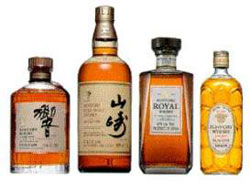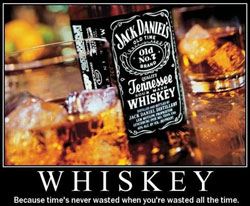 Is it whisky or whiskey? If all Scotches are whiskies, why aren’t all whiskies Scotch? And what about bourbon, Canadian, and Japanese whiskies? The world of whisky can be confusing and somewhat intimidating. Yet, drinking whisky doesn’t have to be all about the “burn.” Far from being a drink for grandpas, hopeless drunks and fat cats, a properly chosen and savored whisky can have all of the subtle aromas and flavor-notes of fine wine. A little knowledge can go a long way in learning to appreciate this centuries old drink, even if you currently don’t give a dram.
Is it whisky or whiskey? If all Scotches are whiskies, why aren’t all whiskies Scotch? And what about bourbon, Canadian, and Japanese whiskies? The world of whisky can be confusing and somewhat intimidating. Yet, drinking whisky doesn’t have to be all about the “burn.” Far from being a drink for grandpas, hopeless drunks and fat cats, a properly chosen and savored whisky can have all of the subtle aromas and flavor-notes of fine wine. A little knowledge can go a long way in learning to appreciate this centuries old drink, even if you currently don’t give a dram.
To “E” or Not to “E”
The beverage produced in Scotland or Canada is spelled whisky (whiskies). If made in Ireland or the United States its spelled whiskey (whiskeys). In both cases, the words descend from the Gaelic uisce beatha (phonetically: ish-ge bah-hah), which in turn comes from the Latin aqua vitae meaning “water of life.”
The Role of Malt
There are two main types of whisky: Malt Whisky and Grain Whisky. Malt whisky is produced entirely from malted barley. Malting is the process of soaking a cereal grain to initiate germination, then rapidly drying the grain to halt the reaction. Grain Whisky is produced from a mixture of malted and un-malted barley along with other grains such as rye, wheat and corn.
Aging Mythology
A bottle of whisky never gets any older (or better). All of whisky’s nuances are created while the liquid ages in charred wood (usually oak) casks. For example, “aged 12 years” indicates the whisky was stored for a minimum of 12 years before bottling. So, that dust-covered bottle of Chivas Regal in the back of your father’s liquor cabinet is no better than the same bottle you can find today in a store. Assuming it was properly stored, it’s no worse either.
Single Malt vs. Blends: Which Is Better?
Is Single Malt Whisky always better than Blended Whisky? Not necessarily. The designation “single malt” only indicates that the whisky was produced at a single distillery from one type of malt. The excellence of the ingredients used and the skill of the distiller determine the quality of the end product. Blended whiskies are the combination of two or more malt and/or grain whiskies. By blending a number of whiskies into a single creation, Master Blenders are able to produce a drink that retains its consistency from year to year and is often greater than the sum of its parts. Johnnie Walker began his career as a blender of teas.
On the Rocks or Neat?
A few drops of water will help “open up” the flavor in any glass of whisky/whiskey. Whether that’s via an ice cube or not is a matter of personal preference. Remember, it’s your drink.
The Whiskeys
Bourbon
 Contrary to popular belief, bourbon does not necessarily have to be produced in Bourbon County Kentucky. To be called bourbon, the drink must be produced entirely in the United States, contain a grain mixture that is at least 51% corn and be aged for a minimum of 2 years, though most American whiskeys bearing the bourbon moniker are produced in the bluegrass state. Virtually all bourbons and American whiskeys use sour mash in their recipes. Sour mash is not the mood you get after drinking, but rather the process of using already fermented grains to season the next batch. The use of corn in the mash creates a drink that is inherently sweeter than Scotch whisky.
Contrary to popular belief, bourbon does not necessarily have to be produced in Bourbon County Kentucky. To be called bourbon, the drink must be produced entirely in the United States, contain a grain mixture that is at least 51% corn and be aged for a minimum of 2 years, though most American whiskeys bearing the bourbon moniker are produced in the bluegrass state. Virtually all bourbons and American whiskeys use sour mash in their recipes. Sour mash is not the mood you get after drinking, but rather the process of using already fermented grains to season the next batch. The use of corn in the mash creates a drink that is inherently sweeter than Scotch whisky.
There are a few other prominent American whiskeys, which do not fall in the bourbon family. These include rye whiskeys like Templeton’s and unique distillers like the venerable Jack Daniel’s, whose Tennessee water source and charcoal filtering create a distinct spirit.
.
Some Brands: Woodford Reserve, Knob Creek, Jim Beam
Best Chicago bourbon sipping spots: Delilah’s (probably the best place for American Whiskey in the United States), Club Lago, Twisted Spoke, Stanley’s
Scotch
 All Scotch whisky is produced in Scotland. Though there are references to Scotch as early as the 15th century, you may notice that most major producers date from the 1820’s or later. This is because prior to the excise act of 1823 it was more profitable for distillers to run illegal stills than it was to follow government regulation. The region in which the Scotch is produced plays a great part in what flavors are imbued. As each Scotch will have its own unique characteristics, the following is only a rough outline.
All Scotch whisky is produced in Scotland. Though there are references to Scotch as early as the 15th century, you may notice that most major producers date from the 1820’s or later. This is because prior to the excise act of 1823 it was more profitable for distillers to run illegal stills than it was to follow government regulation. The region in which the Scotch is produced plays a great part in what flavors are imbued. As each Scotch will have its own unique characteristics, the following is only a rough outline.
- Lowland (Glenkinchie, Bladnoch): The lowland region of Scotland is home to the fewest number of distillers. Scotches tend to be lighter and more subtle, with a “greenness” or grassiness to the flavor and aroma.
- Highlands (Glenmorangie, Oban, Deanston): The largest region geographically, highland Scotches will tend to vary to a greater extent. In general, expect notes of fruit and a mild sweetness on the finish. Those produced in the western highlands may also have a touch of smoke.
- Speyside (The Glenlivet, Glenfiddich, Macallan): Technically part of the highland region, over 50% of all Scottish distilleries are located here. Flavors of malt, with undertones of fruit and a hint of sweetness are prominent in speyside Scotches.
- Islay (Bowmore, Laphroaig, Jura): These are the most robust Scotches, with dominant influences from peat, smoke and even sea salt.
Best sipping spots: Duke of Perth, Clark Street Ale House, Redhead Piano Bar
The Blended Scotches, including Johnnie Walker, Chivas and Dewar’s, comprise the best selling whiskies in the world. Their blends are too numerous to catalog here, but a self-guided tasting can make for a lot of fun.
Irish Whiskey
 Irish whiskeys can be found in both single malt and blended varieties. As a general rule, since peat is rarely used in the production of Irish whiskeys, they are milder, without the presence of smokiness.
Irish whiskeys can be found in both single malt and blended varieties. As a general rule, since peat is rarely used in the production of Irish whiskeys, they are milder, without the presence of smokiness.
Some Brands: Bushmills, Jameson, Midleton
Best Chicago Sipping Spots: In a city with more Irish pubs than Starbuck’s, this shouldn’t be a problem… L&L Tavern, Irish Oak, Chief O’Neill’s, Emmit’s
Canadian Whisky
Virtually all available Canadian whisky brands are blends. With a few notable exceptions, Canadian whisky is known for its value in the checkout aisle and the terrible price it exacts the next day. These are why god created mixed drinks.
Some Brands: Crown Royal, Canadian Mist, Canadian Club
Best Chicago Sipping Spots: Schaller’s Pump, Hideout, your grandpa’s den
Japanese Whisky
 In a blind tasting, Yoichi single cask was rated best among 47 brands from around the world. The only problem with Japanese whisky is that it’s made in Japan. Once that mental hurdle is passed, some interesting surprises await.
In a blind tasting, Yoichi single cask was rated best among 47 brands from around the world. The only problem with Japanese whisky is that it’s made in Japan. Once that mental hurdle is passed, some interesting surprises await.
Some Brands: Suntory, Yoichi, Yamazaki
Best Chicago Sipping Spots: Sam’s Liquors and Binny’s carry some varieties, but these brands haven’t made the cut at most bars

